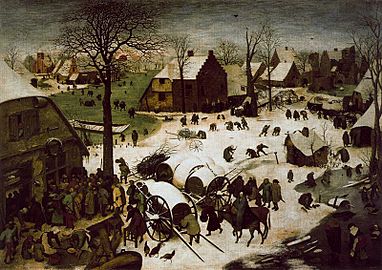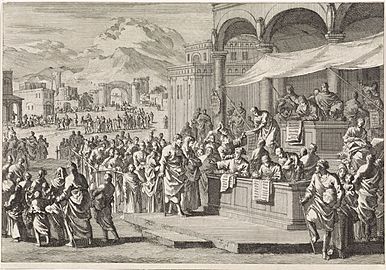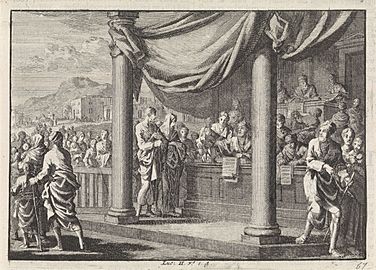Census of Quirinius facts for kids
The Census of Quirinius was like a big count of people and their property in a Roman area called Judea. It happened in 6 CE when the Romans took direct control of Judea. Publius Sulpicius Quirinius, who was the Roman governor of Roman Syria, was in charge of this count.
The Gospel of Luke in the Bible says that Jesus was born around the time of this census. However, the Gospel of Matthew says Jesus was born when Herod the Great was king, who died a few years before the census. Most experts think Luke might have mixed up the dates.
Contents
What was the Census of Quirinius?
Before 6 CE, Judea was ruled by a king named Herod the Great. He was a "client king," meaning he ruled his land but answered to the Roman Empire. When Herod died, his kingdom was split among his sons.
In 6 CE, the Roman Emperor Augustus removed one of Herod's sons, Herod Archelaus, from power. Augustus then turned Archelaus's land into a Roman province called Judea.
Publius Sulpicius Quirinius became the governor of Roman Syria in 6 CE. He was given the job of carrying out a census in the new province of Judea. This census was mainly to figure out how much tax people should pay on their property. People had to register what they owned and who owned it.
This census made some Jewish groups, especially a group called the Zealots, very angry. They rebelled against the Romans, led by a man named Judas of Galilee. The Zealots didn't like the census because they believed it went against their religious laws. They also didn't want to pay taxes using Roman coins that had pictures of the emperor, which they saw as disrespectful.
A old tombstone from the first century mentions a Roman official named Quintus Aemilius Secundus. It says he worked for Quirinius in Syria and helped with the census in a city called Apamea.
The Census in Christianity
The Gospel of Luke's Story
The Gospel of Luke tells a story about Jesus' birth that connects it to this census. It says:
In those days a decree went out from Emperor Augustus that all the world should be registered. This was the first registration and was taken while Quirinius was governor of Syria. All went to their own towns to be registered. Joseph also went from the town of Nazareth in Galilee to Judea, to the city of David called Bethlehem, because he was descended from the house and family of David. He went to be registered with Mary, to whom he was engaged and who was expecting a child.
This part of Luke's story helps explain why Joseph and Mary traveled from their home in Nazareth to Bethlehem, where Jesus was born. The Gospel of Matthew has a different reason for Jesus being born in Bethlehem.
Many experts who study the Bible believe that Luke's account of the census has some historical challenges. For example:
- There wasn't one single census of the entire Roman Empire under Emperor Augustus.
- The Romans usually didn't directly tax "client kingdoms" like Galilee, where Joseph and Mary lived. Galilee was ruled by a different son of Herod, not directly by Rome.
- Roman censuses usually didn't require people to travel from their homes to their ancestors' towns.
The fact that Judas of Galilee led a revolt in Judea because of this new Roman tax suggests that it was a new thing for Judea at that time.
Early Christian Writers
Some Christian writers from the second century AD, like Justin Martyr and Tertullian, wrote that records of the census existed and could prove Jesus' birth.
Justin Martyr wrote that Jesus was born in a village near Jerusalem, and you could check the tax records from Quirinius's time to confirm it.
Tertullian suggested there was a census in Judea when another governor, Sentius Saturninus, was in charge. This was during Herod I's rule, before Rome had direct control of Judea.
Gallery
-
Pieter Bruegel the Elder, The Census at Bethlehem (1566), an oil painting.
-
Jan Luyken, Joseph and Mary taking the census (1700), an etching.
See also
 In Spanish: Censo de Quirino para niños
In Spanish: Censo de Quirino para niños
- Chronology of Jesus
- Date of birth of Jesus
- Gospel harmony
- List of Roman governors of Syria
- Roman administration of Judaea (AD 6–135)
- Roman censor






